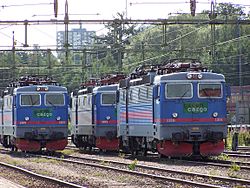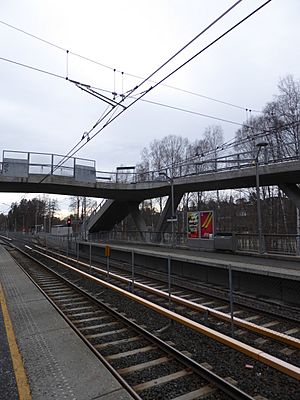Railway electrification system facts for kids
A railway electrification system supplies electrical energy to railway locomotives and multiple units so that they can operate without having an on-board prime mover. Their main advantages are high energy efficiency and low operating cost. Building their wires and other infrastructure is expensive, however.
Contents
Power supply
Electricity may be sent to the train in different ways. Different countries use different systems. The most widely used systems are:
- Alternating current from overhead lines at 15,000 volts, 16.7 Hz
- Alternating current from overhead lines at 25,000 volts, 50 Hz
- Direct current from overhead lines at 1,500 or 3,000 volts
- Direct current from a third rail at 600 or 750 volts
Related pages
Images for kids
-
Transition zone of third-rail to overhead-wire supply on Chicago's Yellow Line (the "Skokie Swift"), shown shortly before the conversion to third rail operation in September 2004.
-
An early rail electrification substation at Dartford
-
Nottingham Express Transit in the UK uses a 750 V DC overhead, in common with most modern tram systems.
-
With top-contact third (and fourth) rail a heavy shoe attached to the underside of a wooden beam which in turn is attached to the bogie, collects power by sliding over the top surface of the conductor rail.
-
London Underground track at Ealing Common on the District line, showing the third and fourth rails beside and between the running rails
-
Bogie from an MP 89 Paris Métro vehicle. The lateral contact shoe is located between the rubber tyres
-
Lots Road Power Station in a poster from 1910. This private power station, used by London Underground, gave London trains and trams a power supply independent from the main power network.
-
The Royal Border Bridge in England, a protected monument. Adding electric catenary to older structures may be an expensive cost of electrification projects
See also
 In Spanish: Sistema de electrificación ferroviaria para niños
In Spanish: Sistema de electrificación ferroviaria para niños

















